Effects of shifting cultivation on biological and biochemical characteristics of soil microorganisms in Khagrachari hill district, Bangladesh
Sohag Miah ? S.M. Sirajul Haque ? Wahida Sumi ? Mohammad Mosharraf Hossain
Effects of shifting cultivation on biological and biochemical characteristics of soil microorganisms in Khagrachari hill district, Bangladesh
Sohag Miah ? S.M. Sirajul Haque ? Wahida Sumi ? Mohammad Mosharraf Hossain
DOI 10.1007/s11676-014-0453-2
We collected soil samples from two representative sites at Aatmile of Khagarachari hill district in Chittagong Hill Tracts. One of the sites was under shifting cultivation and the other an adjacent 13-year old teak plantation. Both sites were in the same physiographic condition and same aspect with parable soil type, which enabled us to measure the effects of shifting cultivation on soil micro-flora. We studied soil physico-chemical properties and the biochemical and biological properties of soil microbes. Moisture and organic matter content as well as fungi and bacterial populations, both in surface and subsurface soils, were significantly (p ≤0.001) lower in shifting cultivated soils compared to soils not under shifting cultivation, i.e. the teak plantation site. The most abundant bacteria in surface (0-10 cm) and sub-surface (10-20 cm) soils under shifting cultivation were Pseudomonas diminuta and Shigella, respectively, while in corresponding soil layers of teak plantation, predominant microbes were Bacillus firmus (0-10 cm) and Xanthomonas (10-20 cm). The microbial population differences cannot be explained by soil texture differences because of the textural similarity in soils from the two sites but could be related to the significantly lower moisture and organic matter contents in soils under shifting cultivation.
shifting cultivation, soil biological properties, soil biochemical properties, soil microflora, Chittagong Hill Tracts
Introduction
Shifting cultivation is blamed for tropical forest conversion to agricultural land and habitat for migrant cultivators who increasingly settle and depart from the traditional shifting cultivation approaches and crops (Rasul et al. 2004; Gibbs et al. 2010). Aadoption of non-conventional approaches and crops by shifting cultivators has brought down the cultivation cycle from 15-20 years to 2-3 years. It causes the farmers to return to the same land at higher frequency which leads to the loss of sustainability of this mode of farming, loss of top soil and development of aluminium, manganese and iron toxicities in soil (Arya 2000). Soils support critical processes such as hydrological and biochemical cycling, they contain a wide array of organisms, and they also provide a nutrient and hydrological reservoir, crucial for survival of below and above ground organisms (Neary et al. 1999). Living microbial populations are the most dynamic among soil components and they undeniably control the fertility and productivity of soil ecosystems. Topsoil is the most active zone of decomposition, nutrient cycling and mycorrhizal formation and becomes the reservoir of bacterial and fungal spores and other propagules of microbes. Re-vegetation of fallow lands followed by shifting cultivation is usually a slow process that does not restore soil microorganisms (Greipsson and El-Mayas 1999). Shifting cultivation uncovers the soil surface at higher elevations and causes erosion by monsoon rain. The shifting cultivators set fire to clear land and this volatilizes nutrients and alters above and below ground composition of soil micro-flora. Consequently, the soil microbial population is altered, which changes the biochemical nature of soil and reduces productivity. Unfortunately, this biological component has largely been ignored as an important aspect of ecosystem functioning.
Chittagong Hill Tracts (CHTs) is the continuation of the Himalayan Mountain Range into three hill districts viz. Rangamati, Khagrachari and Bandarban, and constitutes the most important upland watershed in Bangladesh. CHTs lie in the tropical region (Fig. 1) and comprise of hills of varying elevations accommo-dating about 13 indigenous tribal communities. However, these tribal communities are gradually being outnumbered by mainland settlers in recent waves of migration to hill districts. Consequently, once rich in natural resources, CHTs is rapidly losing its resource base through anthropogenic interventions like illicit deforestation, mass habitation, clear felling followed by burning and failed plantation efforts, and above all shifting cultivation. The rapidly increasing population overwhelms the available land and water resources and is leading to degradation of biodiversity and biological productivity. Though the tribal communities lived in harmony with nature for centuries by adopting a special mode of sloping-land agriculture popularly known as shifting cultivation, the intensified replication of this form of agriculture is causing severe damage to soil and biodiversity. In CHTs, every year, about 200 km2of various categories of forest land is converted to shifting cultivation (Tripura and Harun 2003). Burning of forest vegetation for shifting cultivation is a very common in CHTs. Research has not been reported on the effects of shifting cultivation on biological and biochemical characteristics of soil microbes in this region. While studies on the effects of shifting cultivation on the soil biological environment are essential to elucidate the causes of soil degradation in shifting cultivated land and its consequences, only a few reports have been published (Miah et al. 2010; Haque et al. 2012). Therefore, in our investigation, we evaluated the effects of shifting cultivation on biochemical characteristics and biological properties of soil microbes in terms of the population diversity of microorganisms in the soil environment.
Materials and methods
Site selection
It was challenging to select a study area having a pair of plots, one under shifting cultivation and the other an adjacent natural forest, located on the same or similar topography and with similar soils. This was due to repeated shifting cultivation as well as mismanagement of forest over the past 60 years or more. For this reason, a reconnaissance survey was conducted in Khagrachari Sadar Upazilla to locate such paired plots. Teak plantation was the only option after reconnaissance for selection, because no other vegetation such as natural forest absent over the whole area of Khagrachari sadar upazila due to repeated shifting cultivation, illicit felling etc. In other words, undisturbed land was absent in that region. From the survey, the plots were selected at Aatmile located to the east side of the Khagrachari-Dhiginala Road at Khagrachari district headquarters (Fig. 1). Samples were collected from these plots for determining the effect of shifting cultivation on soil biological environment.
The pair site representing shifting cultivated land and adjacent 13-year teak plantation was selected on the same hill on similar topographical position. Moreover, soil samplings were also done from upper part of hill on the same aspect possessing almost similar textural characteristics (Table 1). Thus, above factors fulfilled the objective to get only the effect of shifting cultivation compared to teak plantation on soil properties.
Shifting cultivated area
This shifting cultivated site, located at 23°11.994′ N and 92°2.221′ E, was on the eastern aspect on the upper part of a hill at 50% slope. On this site, Oryza sativa (paddy) (Fig. 2a), Zea mays (corn), Abelmoschus esculartus (cucumber), Musa paradisiaca (banana) and other crops were grown under shifting cultivation.
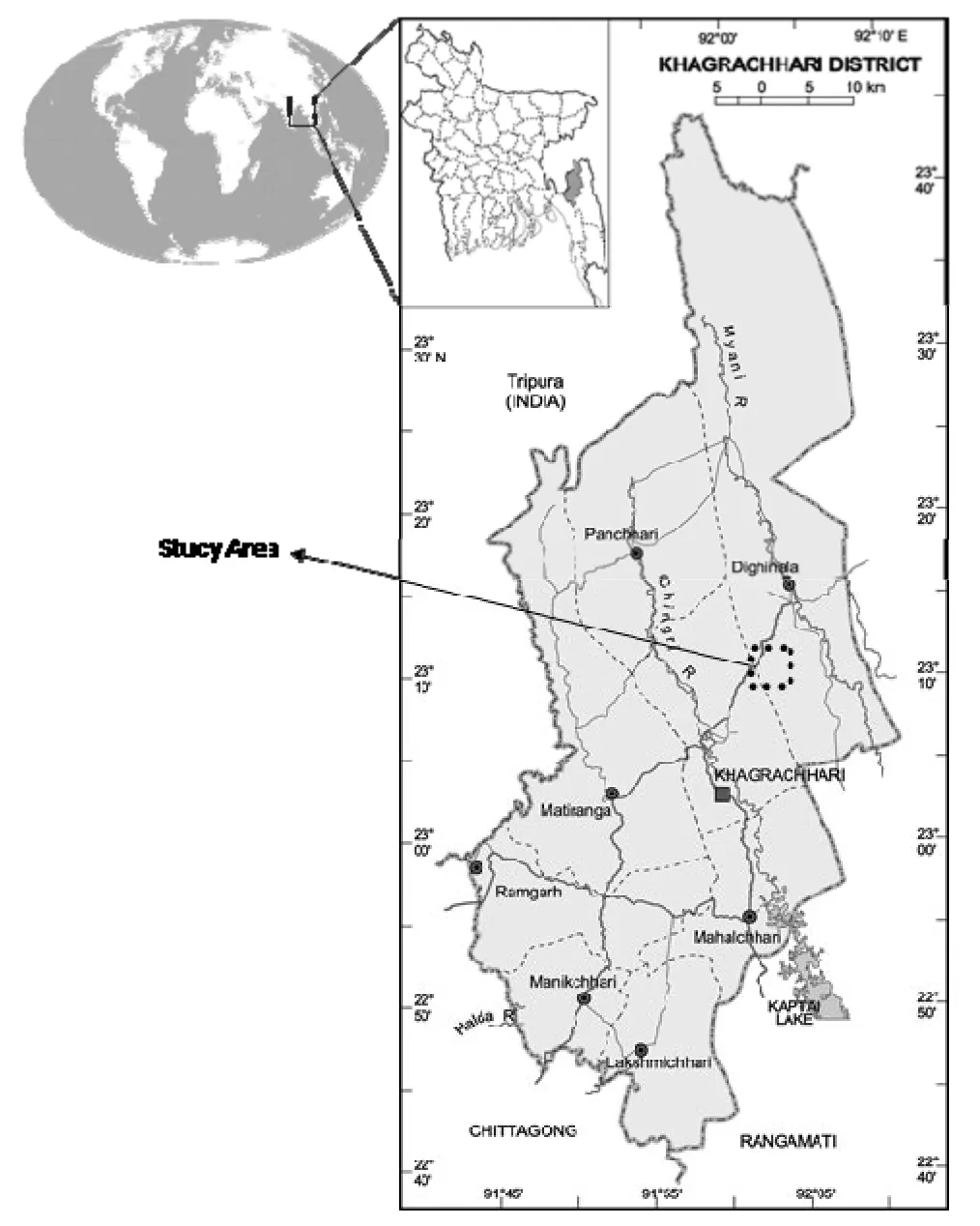
Fig. 1: Location of the study area in context of the world and particularly in context of Bangladesh
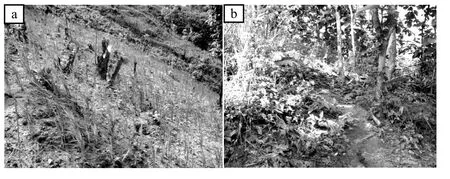
Fig. 2: Sampling sites at Aatmile area in Khagrachari district, (a) shifting cultivated land and (b) 13-year teak plantation
Teak plantation
The neighboring 13-year old teak plantation (Fig. 2b) was located at 23°11.253′ N and 92°2.254′ E on the upper part of a hill on 34% slope. It was also on an easterly aspect with scattered Eupatorium sp. (asamlata) and other shrubs and herbs as undergrowth.
Soil sampling
Soils were collected from three replicated 10 m × 10 m plots in each land use type. Five soil samples were randomly collected from 0-10 cm and 10-20 cm soil depths separately from each plot. Soil samples from each depth were mixed together to give a composite sample. Labeled poly bags sterilized with 95% ethyl alcohol were used to carry samples to the laboratory. In the laboratory, samples were divided into two subsoil samples: one used for determination of physical and chemical properties and the other kept in refrigerator at 4°C for determining biological properties.
Physico-chemical properties
Moisture content was determined by drying the soil in an oven at 105°C for 8 hours. In the laboratory, the sieved dry soil sample was used for determination of soil texture by the Bouyoucos hydrometer method (Huq and Alam 2005) and moist soil pH determined by a TOA pH meter in triplicate at 1:2 soil-water ratios. Soil organic matter was determined using the loss on ignition method according to Ball (1964).
Microbial population determination
Fungi
Potato dextrose agar (PDA) media was used for culturing fungi. For serial dilution 1g of sieved soil (passed through 2 mm mesh size) was dispersed in 99 mL sterile water in a conical flask to produce 10-2dilution, from which 1 mL suspension was removed using a sterilized pipette and mixed thoroughly adding 99 mL sterile water in another conical flask to give 10-4dilution. In this way dilutions were made up to10-5. Dilutions of 10-3, 10-4and 10-5were used for culturing and isolation of fungi. Three replicated composite soil samples were analyzed for each depth and land use for making such dilutions. Exactly, 0.1 mL streptomycin sulfate (0.25 mg?mL-1) solution was added and spread on PDA media in a Petri-dish to inhibit bacterial growth and then was allowed to solidify (Miah et al. 2010).
From the dilution series, 1 mL soil suspension was spread over the solidified media in Petri-dishes. After 72 hours incubation all Petri-dishes were examined. Petri-dishes which had >300 or <30 colonies on the plates were discarded (Clark 1965). Colonies of diameter greater than 2 cm in any plate were also discarded. Total number of colonies on each of the acceptable plates was counted using a colony counter and the result expressed as Colony Forming Unit (cfu) according to Clark (1965).
Bacteria
For culturing bacteria, nutrient agar (NA) media was used and dilutions made up to10-9. Dilutions 10-7, 10-8and 10-9were used for bacterial culture. Each of the dilutions in conical flasks was shaken vigorously for 10 min. Nystate solution (0.005 mg?mL-1) was used as the antifungal for the culture (Miah et al. 2010). After 24 hours of incubation all Petri-dishes were examined.
Isolation and identification of bacteria
After counting bacterial populations, discrete colonies were immediately isolated. On the basis of colony morphology, different colonies were selected for isolation. Characteristics of the colonies such as colour, form, elevation, margin, and surface were recorded. Selected colonies were transferred to nutrient agar slant for further studies. Isolated organisms were purified through repeated plating using streak plates (Fig. 3a and 3b) on nutrient agar media. When a plate yielded only one type of colony, the colony was considered as pure culture, which was subsequently confirmed through microscopic observation. The isolates were then transferred to nutrient agar slants kept in polythene bags and preserved as stock cultures in a refrigerator at 4°C. Occasional sub culturing was done at every 3-4 weeks to ensure the culture remained active and uncontaminated. Final selection of isolates was based on the best colony morphology on agar plates and agar slants, and on microscopic features seen under a light microscope. Identification of microorganisms from isolates was a sequential process that consisted of a series of experiments. In addition to the estimation of total microbial diversity, we also identified the major bacterial population to genus or species based on morphological, cultural and biochemical characteristics (Table 4 and 5) of bacterial isolates from the surface soil.
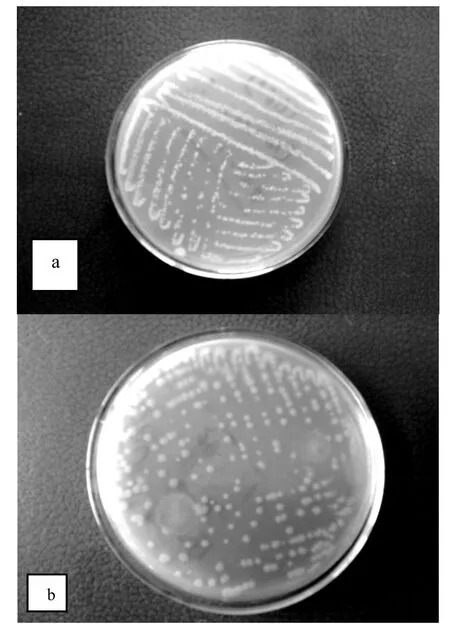
Fig. 3: Isolated organisms were purified through repeated plating using streak plate, (a) is the streak plate and (b) isolated discrete colony in nutrient agar media
Statistical analysis
One way ANOVA was applied to triplicate data to determine significance levels for means between the two land uses using SPSS 16.
Results and discussion
Physico-chemical properties
Soil texture in surface and subsurface soils varied from sandy loam to sandy clay loam in both the current year shifting cultivated land and teak plantation (Table 1). Moisture content and organic matter were significantly (p≤0.001) lower and pH higher in surface and subsurface soils from all three plots in shifting cultivated land than in teak plantation (Table 2). Surface soil in shifting cultivation showed, on average, 14% moisture, 1.09% organic matter and pH 4.73, while in teak plantation, values were 19.22%, 1.68% and 4.29, respectively. The higher moisture and organic matter content in teak plantation soils were due to the progressive addition of biomass to the soil through litter fall and reduced loss thereof from the soil due to vegetation cover. This and other studies of the tropical region indicate that shifting cultivation greatly reduces soil moisture and organic matter content (Haque et al. 2011; Miah et al. 2010; Yang et al. 2004).
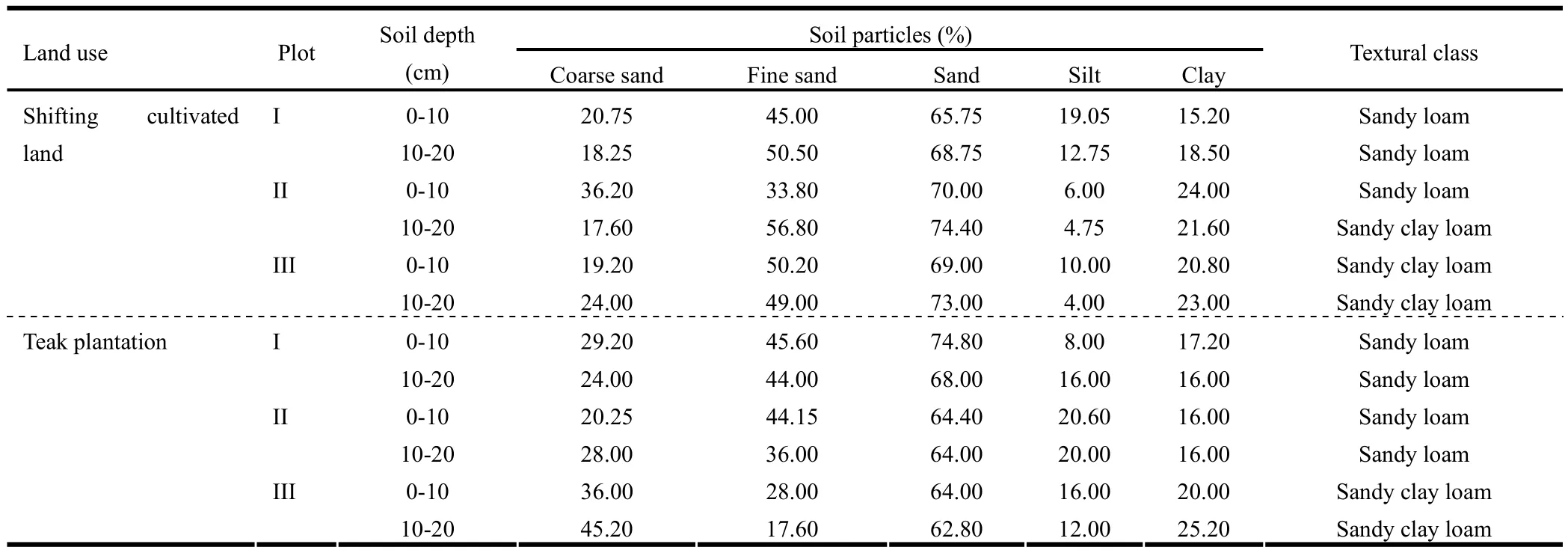
Table1: Texture of soils from shifting cultivated land and adjacent teak plantation at Khagrachari hill district
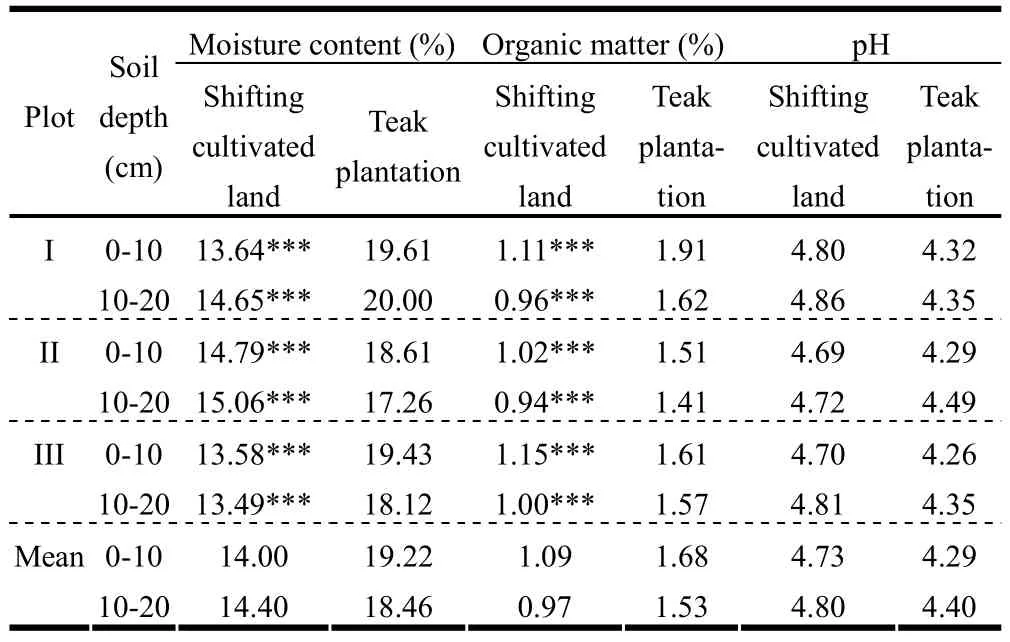
Table 2: Physico-chemical properties of soil from shifting cultivated land and adjacent teak plantation at Khagrachari hill district
Microbial diversity
Both fungi and bacterial populations were significantly (p≤0.001) lower in shifting cultivated soils than in soils from teak plantation for both soil depths from all three plots (Table 3). On average, bacterial populations in surface soil were 4.60×106cfu·g-1in shifting cultivated soil and 3.9×107cfu·g-1in teak plantation, and their corresponding values in subsurface soils were 6.6×106cfu·g-1and 2.2×107cfu·g-1. Fungal populations in surface soil was 1.7×105cfu·g-1in shifting cultivation and 4.4×105cfu·g-1in teak plantation, and corresponding values in subsurface soil were 1.4×105cfu·g-1and 3.5×105cfu·g-1(Table 3). Shifting cultivation drastically reduced fungi and bacterial populations in surface and subsurface soils. Other reports from tropical regions document that shifting cultivation greatly reduces populations of these two organisms (Haque et al. 2012; Miah et al. 2010; Arunachalam 2002).
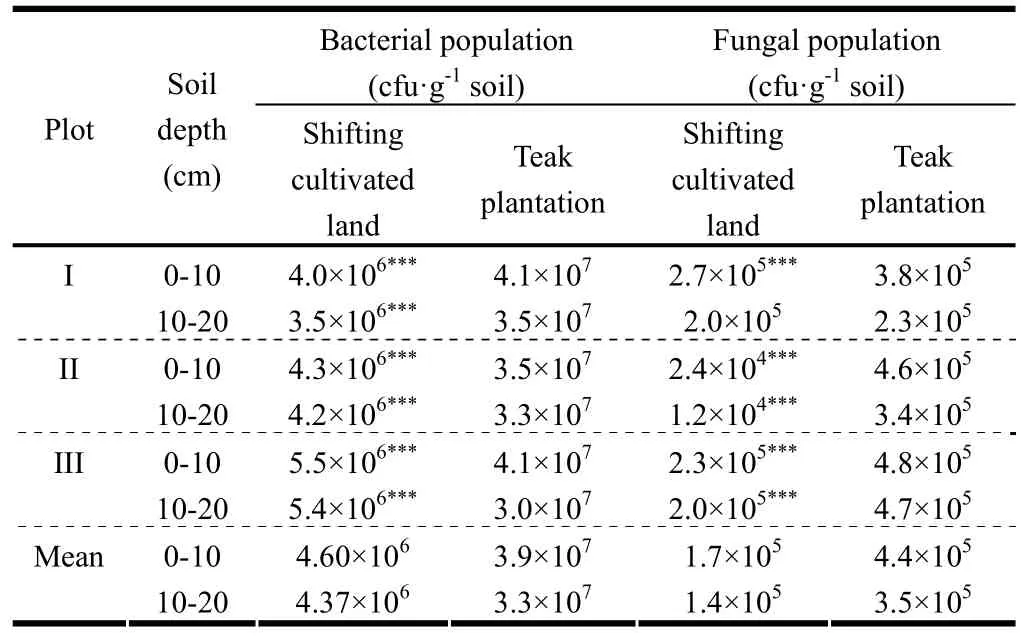
Table 3: Microbial populations in soils from shifting cultivated land and adjacent teak plantation at Khagrachari hill district
Biochemical characteristic based identification of bacteria
In soils from shifting cultivation site, the prominent bacteria in surface (0-10 cm) were Pseudomonas diminuta and in sub-surface (10-20 cm) Shigella. On the other hand, in soil from teak plantation, the respective predominant microbes were Bacillus firmus and Xanthomonas. Shifting cultivated land supported the genus Pseudomonas with species similar to P. diminuta, according to the description by Bhucanon and Gibbons (1974). However, species identification differed in the results of the catalaze test. Identified bacterial species in surface soil of the teak plantation was Bacillus firmus (Table 4). In the subsurface soil of shifting cultivated land one identified bacterial genus was Shigella and in teak plantation was Xanthomonas. Most of the biochemical properties studied indicated the presence of these two bacterial species except for a few tests (Table 5). In both the land uses for subsurface soil, species could not be identified because Shigella showed non-deterministic growth in nutrient broth and gave non-conforming results in H2S production in TSI agar slants and catalaze tests. Similarly, though most of the biochemical tests indicated the presence of the bacterial genus Xanthomonas, some fermentation tests did not yield agreeable results (Table 5).
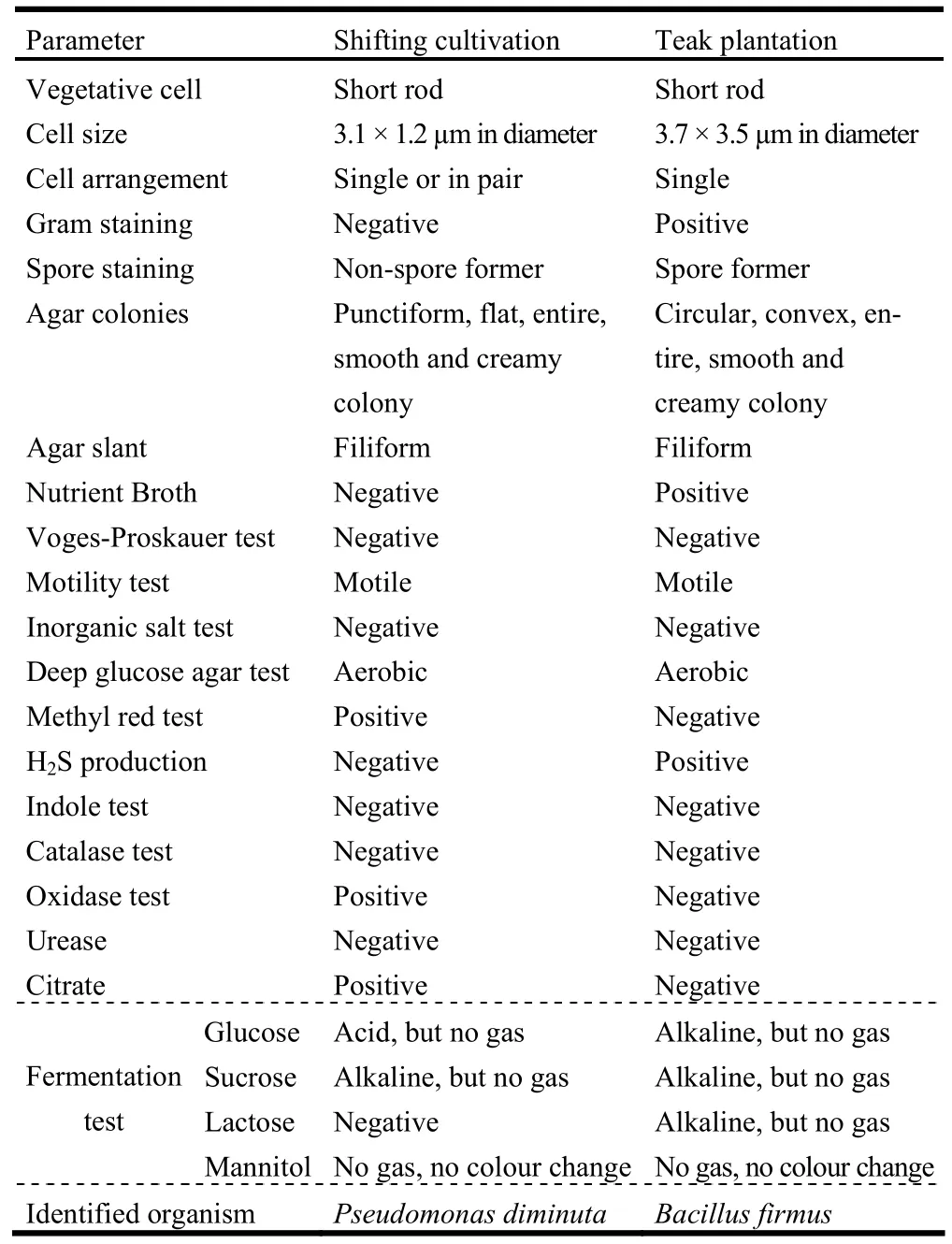
Table 4: Morphological, cultural and biochemical characteristics of bacterial isolates in soils at 0-10cm depths collected from shifting cultivated land and adjacent Teak plantation at Khagrachari hill district
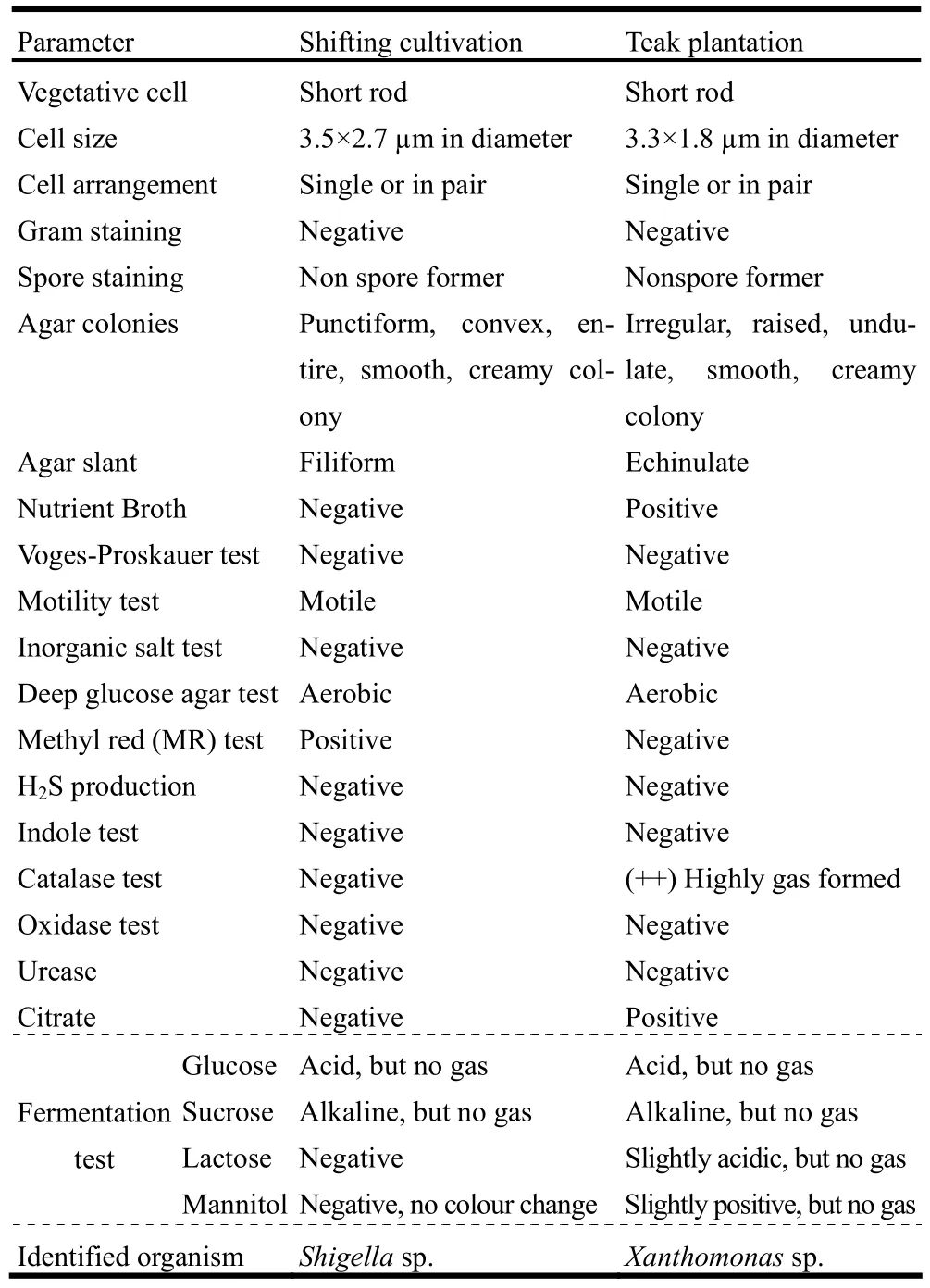
Table 5: Morphological, cultural and biochemical characteristics of bacterial isolates in soils at 10-20cm depths collected from shifting cultivated land and adjacent Teak plantation at Khagrachari hill district
Fungal and bacterial populations in shifting cultivated land at both soil depths were associated with lower moisture and organic matter content compared to teak plantations (Table 2). Through reduction in the amount of organic matter due to shifting cultivation, which included burning to prepare land, populations of fungi and bacteria in soil were significantly reduced (Table 3). Forests maintain relatively slow oxidation due to cool and shaded conditions (Dick et al. 1998) which ultimately increase the moisture content. Moreover, the immediate effect of fire on soil microorganisms is a reduction of their biomass and in extreme cases the topsoil can undergo complete sterilization (Certini 2005). Adverse effects on soil biota also can be due to some organic pollutants produced by the combustion processes. Different toxic compounds, such as polychlorinated dibenzo-p-dioxins (PCDDs), dibenzofurans (PCDFs) and polynuclear aromatic hydrocarbons (PAHs) are released during fire and redistributed on the ground (Kim et al. 2003). Heat also indirectly affects survival and colonization of soil organisms through reduction and modification of organic substrates, removal of sources of organic residues, and buffering. Miah et al. (2010) observed lower fungi and bacterial population both in surface and subsurface soils in shifting cultivated land compared to village common forest in the same hilly region of Bangladesh. Arunachalam (2002) recorded less bacteria and fungi colonies in jhum field compared to forest in a humid tropical zone of India.
The lower values of both the bacterial and fungal populations in current year shifting cultivated soils indicated detrimental effects of this cultivation mode on the biochemical properties of soils. Due to shifting cultivation soils become nutritionally poorer due to the loss of biomass from the system through slash felling, burning, crop harvest and subsequent fallow periods that promote shallow rooted, low biomass shrubby vegetation which makes the soil unfavorable for nutrient recycling and the growth of micro-flora. At the same time, as shown by Gafur et al. (2003), the slash and burn in shifting cultivation exposes the soil to runoff erosion by rainfall and wind weathering which aggravate the loss of nutrients as evident from the classic model proposed by Nye and Greenland (1960). Moreover, the diversity of soil microbial populations enhances the diversity of biochemical cycles and results in better nutritional status. Soils under shifting cultivation lose resilience in nutrient recycling due to the changes in diversity of soil microbial populations during burning and subsequent soil biochemical changes which further impoverish the soil bio-chemically.
The differences in microbial population count and population composition cannot be universal for all shifting cultivation sites; however, it can explain the unavoidability in the variations of the biological and biochemical characteristics of soil micro-flora in shifting cultivated areas and emphasize the necessity of taking this factor into consideration in management of soils in fellow lands after shifting cultivation.
Conclusion
Shifting cultivation had detrimental effects on soil properties, particularly on the diversity and abundance of microbial populations as compared to monoculture teak plantation. Teak plantation does not represent ecological conditions of natural forest because it lacks undergrowth and is more subject to intense surface soil erosion in a country like Bangladesh that experiences heavy rainfall during the monsoon season. Therefore, our comparison of land resource degradation and biodiversity loss in shifting cultivation versus teak plantation would be further exaggerated in a comparison of shirting cultivation with natural forest. The adverse impacts of shifting cultivation have not been mitigated by habitat restoration in more than a century. This needs to be considered at national policy level with respect to proposed policy interventions related to shifting cultivation.
Acknowledgement
The authors highly appreciate United States Department of Agriculture (USDA) for funding this research.
Arunachalam A. 2002. Dynamics of soil nutrients and microbial biomass during first year cropping in an 8-year jhum cycle. Nutrient Cycling in Agroecosystems, 64: 283–291.
Arya LM. 2000. Final consultancy reports on hill agriculture. Agricultural Research Management Projects (ARMP), Gazipur, Dhaka: Bangladesh Agricultural Research Institute.
Ball DF. 1964. Loss on ignition as an estimate of organic matter and organic carbon in non-calcareous soils. Journal of Soil Science, 15: 84-92.
Buchanon RE, Ghibbon NE. 1974. Bergey’s Mannual of Determinative Bacteriology (8th edition). Baltimore: Williams and Wilkins Co..
Certini G. 2005. Effects of fire on properties of forest soils: a review. Oecologia, 143: 1–10.
Clark FE. 1965. Agar-plate method for total microbial count. In: Black CA, Evans DD, Ensminger LE, White JL, Clark FE (Eds). Methods of soil analysis Part 2 chemical and microbiological propertie. Wisconsin: American Society of Agronomy, Inc., pp. 1460-1466.
Dick WA, Blevins RL, Frye WW, Peters SE, Christenson DR, Piece FJ, Vitosh ML. 1998. Impacts of agricultural management practices on C sequestration in forest-derived soils of the eastern Corn Belt. Soil & Tillage Research, 47: 235-244.
Gafur A, Jensen JR, Borggaard OK, Petersen L. 2003. Runoff and losses of soil and nutrients from small watersheds under shifting cultivation (Jhum) in the Chittagong Hill Tracts of Bangladesh. Journal of Hydrology, 279: 30–46.
Gibbs HK, Ruesch AS, Achard F, Clayton MK, Holmgren P, Ramankutty N, Foley JA. 2010. Tropical forests were the primary sources of new agricultural land in the 1980s and 1990s. PANS, 107(38): 16732–16737.
Greipsson S, El-Mayas H. 1999. Large-scale reclamation of barren lands in Iceland by aerial seeding. Land Degradation & Development, 10: 185–193.
Haque SMS, Ferdoshi R, Miah S, Anwar MN. 2012. Clear felling and burning effects on soil nitrogen transforming bacteria and actinomycetes population in Chittagong University campus, Bangladesh. Journal of Forestry Research, 23(1): 123-130.
Huq SMI, Alam MDU. 2005. A Handbook on Analyses of Soil, Plant and Water. Dhaka: Bangladesh-Australia Center for Environmental Research (BACER-DU), p. 246.
Yang JC, Huang JH, Pan QM, Tang JW, Han XG. 2004. Long-term impacts of land-use change on dynamics of tropical soil carbon and nitrogen pools. Journal of Environmental Science, 16(2): 256-261.
Kim EJ, Oh JE, Chang YS. 2003. Effects of forest fire on the level and distribution of PCDD/Fs and PAHs in soil. Science of the Total Environment, 311: 177–189.
Miah S, Dey S, Haque SMS. 2010. Shifting cultivation effects on soil fungi and bacterial population in Chittagong Hill Tracts, Bangladesh. Journal of Forestry Research, 21(3): 311-318.
Neary DG, Klopatek CC, Debano LF, Ffolliott PF. 1999. Fire effects on below ground sustainability: a review and synthesis. Forest Ecology and Management, 122: 51–71.
Nye PH, Greenland DJ. 1960. The soil under shifting cultivation. Terch Comm. No. 51, Commonwelth Bureau of Soils Harpenden, England, p. 156.
Rasul G, Thapa GB, Zoebisch MA. 2004. Determinants of land-use changes in the Chittagong Hill Tracts of Bangladesh. Applied Geography, 24: 217–240.
Tripura P, Harun A. 2003. Crisis and struggle of shifting cultivator in the CHTs. Dhaka: Women Volunteers Association, June 12-13, pp. 1-7.
2011-10-15; Accepted: 2012-12-13
Project funding: The authors highly appreciate United States Department of Agriculture (USDA) for funding this research
The online version is available at http://www.springerlink.com
Sohag Miah ? S.M. Sirajul Haque ()
Institute of Forestry and Environmental Sciences, University of Chittagong, Chittagong-4331, Bangladesh. E-mail: sms_haque@yahoo.com
Wahida Shumi
Department of Microbiology, University of Chittagong, Chittagong-4331, Bangladesh.
Mohammad Mosharraf Hossain
Department of Applied Physics, Graduate School of Engineering, Osaka University, 2-1 Yamadaoka, Suita, Osaka 565-0871, Japan.
Corresponding editor: Yu Lei
? Northeast Forestry University and Springer-Verlag Berlin Heidelberg 2014
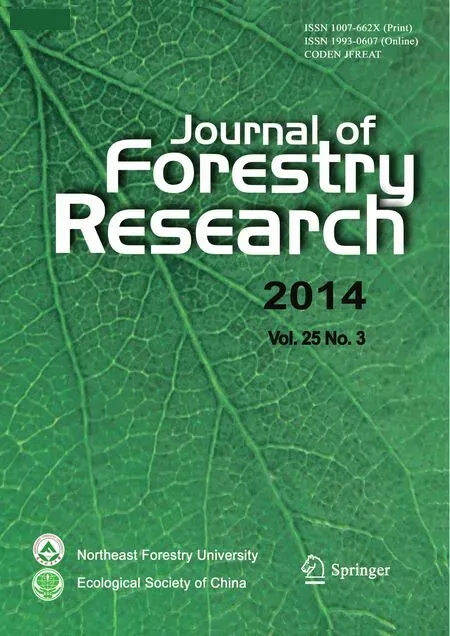 Journal of Forestry Research2014年3期
Journal of Forestry Research2014年3期
- Journal of Forestry Research的其它文章
- An integrated method for matching forest machinery and a weight-value adjustment
- Finite element analysis of stress and strain distributions in mortise and loose tenon furniture joints
- The in fl uence of silane coupling agent and poplar particles on the wettability, surface roughness, and hardness of UF-bonded wheat straw (Triticum aestivum L.)/poplar wood particleboard
- A modified Murashige and Skoog media for efficient multipleshoot induction in G. arborea Roxb.
- Genetic variation and selection of introduced provenances of Siberian Pine (Pinus sibirica) in frigid regions of the Greater Xing’an Range, Northeast China
- Characterization of expressed genes in the establishment of arbuscular mycorrhiza between Amorpha fruticosa and Glomus mosseae
